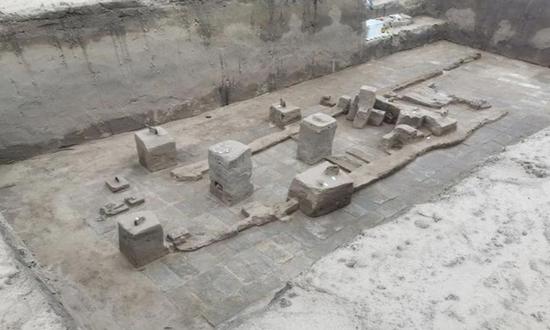1,000-year-old burial chariot unearthed in Inner Mongolia

A burial chariot dating back to the Liao Dynasty (916-1125), founded by the nomadic Khitan, has been discovered in North China's Inner Mongolia Autonomous Region. This discovery offers a glimpse into the burial customs of the Khitan nobility, The Paper reported on Monday.
The archaeological find, including a tomb and an accompanying burial chariot pit,was made by a team conducting excavations in a village of Kailu county.
Despite the decay of wooden shaft of the chariot, several iron components and gilded fittings have been preserved.
"The chariot measures 7 meters in length and 2 meters in width, which is quite rare in scale. This is the first discovery of this kind of Liao tomb excavations in Kailu. The site has not been disturbed by grave robbers, and all the information has been essentially preserved," said Ma Hai, director of the Kailu County Museum.
The chariot, identified as a ceremonial burial object, is indicative of the funerary practices among the Khitan nobility during the Liao Dynasty. "We found a wooden shaft, carriage, and, most importantly, gilded bronze bells and tassels within the pit, suggesting the burial was for a noble," said Qi Rongqing, a faculty member at the Inner Mongolia Normal University.
The burial chariot pit has yielded more than 30 artifacts, including silver ornaments, copper tassels, iron components, and gilded bronze bells.
The finding of these tombs dates back to April 2023, when the Inner Mongolia Institute of Cultural Relics and Archaeology conducted a survey in Kailu. By June, a joint archaeological team began the excavation of the tombs, which has now been completed.
"Tomb No. 1, based on its scale, is a medium-sized tomb," said Qi. "The use of large stones for the tomb roof, extensive mural paintings, and the inclusion of rare materials like gold, silver, agate, turquoise, and obsidian among the burial items, indicate the tomb's owner held a significant social status."
According to Qi, Khitan burials are generally simpler compared with those in the Central Plains, reflecting distinct ethnic characteristics. After establishing the Liao Dynasty, the Khitan adopted certain elements of Central Plains culture, such as using clay bricks, particularly the grooved bricks for construction, a fact that illustrates the cultural integration and adaptation that took place in the area.
